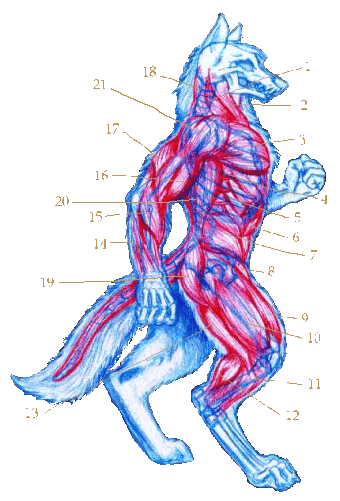Anatomy of Werwolfs
Physiology of Werewolves
The werewolf occupies a special position among mammals. It is neither wolf nor human. Although its appearance is more or less the same as that of a hermaphrodite from both species, depending on the degree of transformation, it has fundamental physiological differences to both species.
The appearance of a werewolf is always extremely muscular and its physical performance
levels do not take this into account at all, but far exceed expectations. The efficiency
of the motor skills is enormously increased to that of the human being and also
the metabolism is strongly accelerated. This has to result in an increased energy
flow, which provides the basis for the notorious brute force of Garou's attacks. But
this is also the explanation for their enormous convalescence abilities, but also
for the necessity of increased food intake. In other words, a werewolf always has an
appetite for a juicy bite, but this does not automatically make him a men-eater.
Assimilation (internal respiration or cellular respiration) is no different from that
of humans or wolves. As with all animals, cell energy is stored in the form of ATP
(adenosine triphosphate) and released again when required (muscle contraction) in the
form of the elimination of a phosphate group. The ATP is converted into ADP + P (ADP:
adenosine diphosphate, P: phosphate).
 |
|
||||||||||||||||||||||||||||||||||||||||||
| Fig. 1: Musculature of a werewolf |
|---|
The question now arises as to what increases the efficiency of the individual muscle fibrils and how the werewolf body can absorb the high load peaks without suffering damage such as muscle fibre tears, bone fractures and tendon tears.
Shapeshifting
 First of all: If there is a transformation of form or "New German" shapeshifting, a lot
more is transformed than just the outer form. Rather, the transformation takes place at
the molecular level, to which the muscles, tendons and bone tissue are subject. Through
this molecular restructuring, the werewolf organism acquires the abilities that its existence
as Loup Garou demands of it. How the restructuring takes place in detail, however, is beyond
my knowledge. It should only be mentioned here that the organism is walking a tightrope walk
in this process between performance optimization and survivability.
First of all: If there is a transformation of form or "New German" shapeshifting, a lot
more is transformed than just the outer form. Rather, the transformation takes place at
the molecular level, to which the muscles, tendons and bone tissue are subject. Through
this molecular restructuring, the werewolf organism acquires the abilities that its existence
as Loup Garou demands of it. How the restructuring takes place in detail, however, is beyond
my knowledge. It should only be mentioned here that the organism is walking a tightrope walk
in this process between performance optimization and survivability.
It is easy to see that a change of shape consumes an enormous amount of energy and can therefore
not often be carried out by the werewolf. From this circumstance probably the superstition arose
that a werewolf, as wrongly shown on the right, can only assume the shape of a wolf on full moon
nights. In fact, the transformation ability is not subject to moon phases and does not depend on
the respective day phase.
Last modified at 29.12.2018



